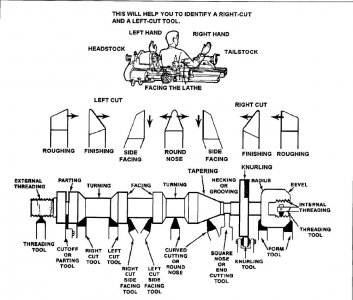Use the above diagram to help orient tools. HSS tools are better for a light lathe.
Also,though,be sure to orient the tools in the holder so that if they slip some under the sideways pressure of a cut,they will swing AWAY from the metal instead of swinging into it,causing a deeper cut and possibly overloading or crashing the machine. This applies to any size lathe.
I'll also mention that round nosed tools are much harder for a small lathe to handle. They strain everything due to increased contact and cutting area on the metal. Your tools need to be rounded a LITTLE bit to make a smooth cut. But,the roundness only needs to be enough to span the width of the cut you are taking,in order to not leave a tiny "threaded" looking cut. I hope this is clear enough. In other words: If your sideways feed is .004" per revolution,a tip diameter of .008" will be plenty to span that width. You can gauge the diameter by eye as it would be hard to measure. You CAN open your dial caliper by that amount and see how big the diameter should look. Practice is important.


